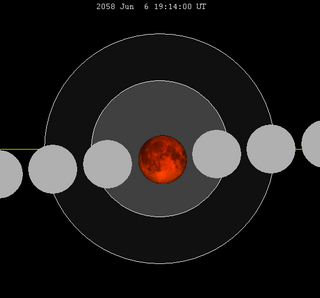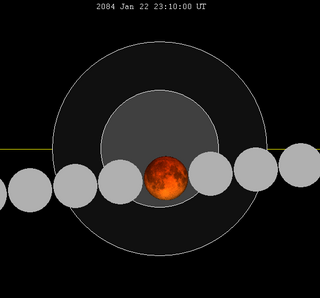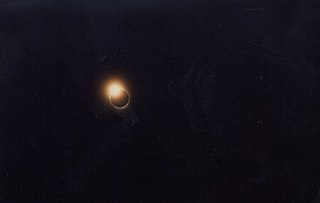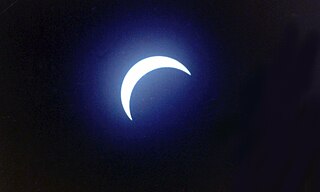| Total eclipse | |||||||||||||||||
| Date | September 15, 1913 | ||||||||||||||||
|---|---|---|---|---|---|---|---|---|---|---|---|---|---|---|---|---|---|
| Gamma | -0.2109 | ||||||||||||||||
| Magnitude | 1.4304 | ||||||||||||||||
| Saros cycle | 126 (39 of 70) | ||||||||||||||||
| Totality | 93 minutes and 29 seconds | ||||||||||||||||
| Partiality | 230 minutes and 33 seconds | ||||||||||||||||
| Penumbral | 373 minutes and 1 second | ||||||||||||||||
| |||||||||||||||||
A total lunar eclipse took place on Monday, September 15, 1913. The moon passed through the center of the Earth's shadow. [1]
The inex series repeats eclipses 20 days short of 29 years, repeating on average every 10571.95 days. This period is equal to 358 lunations (synodic months) and 388.5 draconic months. Saros series increment by one on successive Inex events and repeat at alternate ascending and descending lunar nodes.
This period is 383.6734 anomalistic months (the period of the Moon's elliptical orbital precession). Despite the average 0.05 time-of-day shift between subsequent events, the variation of the Moon in its elliptical orbit at each event causes the actual eclipse time to vary significantly. It is a part of Lunar Inex series 40.
All events in this series shown (from 1000 to 2500) are central total lunar eclipses.
| Descending node | Ascending node | Descending node | Ascending node | ||||
|---|---|---|---|---|---|---|---|
| Saros | Date | Saros | Date | Saros | Date | Saros | Date |
| 95 | 1016 May 24 | 96 | 1045 May 3 | 97 | 1074 Apr 14 | 98 | 1103 Mar 25 |
| 99 | 1132 Mar 3 | 100 | 1161 Feb 12 | 101 | 1190 Jan 23 | 102 | 1219 Jan 2 |
| 103 | 1247 Dec 13 | 104 | 1276 Nov 23 | 105 | 1305 Nov 2 | 106 | 1334 Oct 13 |
| 107 | 1363 Sep 23 | 108 | 1392 Sep 2 | 109 | 1421 Aug 13 | 110 | 1450 Jul 24 |
| 111 | 1479 Jul 4 | 112 | 1508 Jun 13  | 113 | 1537 May 24 | 114 | 1566 May 4 |
| 115 | 1595 Apr 24 | 116 | 1624 Apr 3 | 117 | 1653 Mar 14 | 118 | 1682 Feb 21 |
| 119 | 1711 Feb 3 | 120 | 1740 Jan 13 | 121 | 1768 Dec 23 | 122 | 1797 Dec 4 |
| 123 | 1826 Nov 14 | 124 | 1855 Oct 25 | 125 | 1884 Oct 4 | 126 | 1913 Sep 15  |
| 127 | 1942 Aug 26  | 128 | 1971 Aug 6  | 129 | 2000 Jul 16  | 130 | 2029 Jun 26  |
| 131 | 2058 Jun 6  | 132 | 2087 May 17  | 133 | 2116 Apr 27 | 134 | 2145 Apr 7 |
| 135 | 2174 Mar 18 | 136 | 2203 Feb 26 | 137 | 2232 Feb 7 | 138 | 2261 Jan 17 |
| 139 | 2289 Dec 27 | 140 | 2318 Dec 9 | 141 | 2347 Nov 19 | 142 | 2376 Oct 28 |
| 143 | 2405 Oct 8 | 144 | 2434 Sep 18 | 145 | 2463 Aug 29 | 146 | 2492 Aug 8  |
It is part of saros series 126 .
Lunar saros series 126, repeating every 18 years and 11 days, has a total of 70 lunar eclipse events including 14 total lunar eclipses. Solar Saros 133 interleaves with this lunar saros with an event occurring every 9 years 5 days alternating between each saros series.
First penumbral lunar eclipse: 18 July 1228
First partial lunar eclipse: 24 March 1625
First total lunar eclipse: 19 June 1769
First central lunar eclipse: 11 July 1805
Greatest eclipse of the lunar saros 126: 13 August 1859, lasting 106 minutes.
Last central lunar eclipse: 26 September 1931
Last total lunar eclipse: 9 November 2003
Last partial lunar eclipse: 5 June 2346
Last penumbral lunar eclipse: 19 August 2472
1901-2100
A lunar eclipse will be preceded and followed by solar eclipses by 9 years and 5.5 days (a half saros). [2] This lunar eclipse is related to two total solar eclipses of Solar Saros 133.
| September 9, 1904 | September 21, 1922 |
|---|---|
 |  |

A total lunar eclipse will take place on Tuesday, March 3, 2026.

A total lunar eclipse took place on Sunday 16 July 2000, the second of two total lunar eclipses in 2000.

A partial lunar eclipse took place on Monday, March 24, 1997, the first of two lunar eclipses in 1997.

A total lunar eclipse will take place on May 26, 2040. The northern limb of the moon will pass through the center of the Earth's shadow. This is the second central lunar eclipse of Saros series 131.

A total lunar eclipse will take place on Tuesday, June 26, 2029. A dramatic total eclipse lasting 1 hour and 41 minutes 53 seconds will plunge the full Moon into deep darkness, as it passes right through the centre of the Earth's umbral shadow. While the visual effect of a total eclipse is variable, the Moon may be stained a deep orange or red color at maximum eclipse. This will be a great spectacle for everyone who sees it from most of the Americas and western Europe and Africa. The partial eclipse will last for 3 hours and 39 minutes 32 seconds in total.

A total lunar eclipse took place on Tuesday, July 6, 1982. A dramatic total eclipse lasting 1 hour and 46 minutes plunged the full Moon into deep darkness, as it passed right through the centre of the Earth's umbral shadow. While the visual effect of a total eclipse is variable, the Moon may have been stained a deep orange or red colour at maximum eclipse. This was a great spectacle for everyone who saw it. The partial eclipse lasted for 3 hours and 56 minutes in total. It was the second of three total lunar eclipses in 1982.

A total lunar eclipse took place on Friday, August 6, 1971. The moon passed through the center of the Earth's shadow.

A total lunar eclipse took place on Wednesday, May 3, 1939. A shallow total eclipse saw the Moon in relative darkness for 1 hour and 2 minutes. The Moon was 18% of its diameter into the Earth's umbral shadow, and should have been significantly darkened. The partial eclipse lasted for 3 hours and 27 minutes in total.

A total lunar eclipse took place on Saturday, April 13, 1968, the first of two total eclipses in 1968, the second being on October 6, 1968.

A total lunar eclipse will take place on June 6, 2058. The moon will pass through the center of the Earth's shadow.

A total lunar eclipse took place on Sunday, July 26, 1953.

A total lunar eclipse took place on Wednesday, August 26, 1942. The moon passed through the center of the Earth's shadow.

A total lunar eclipse will take place on May 17, 2087. The moon will pass through the center of the Earth's shadow.
A total lunar eclipse took place at the Moon's descending node of the orbit on Tuesday, May 24, 1910 with an umbral eclipse magnitude of 1.09503. A total lunar eclipse takes place when the Earth comes between the Sun and the Moon and its shadow covers the Moon. Eclipse watchers can see the Moon turn red when the eclipse reaches totality. Total eclipses of the Moon happen at Full Moon when the Sun, Earth, and Moon are aligned to form a line. The astronomical term for this type of alignment is syzygy, which comes from the Greek word for being paired together. The Moon does not have its own light but shines because its surface reflects the Sun's rays. During a total lunar eclipse, the Earth comes between the Sun and the Moon and blocks any direct sunlight from reaching the Moon. The Sun casts the Earth's shadow on the Moon's surface. A shallow total eclipse saw the Moon in relative darkness for 49 minutes and 29.5 seconds. The Moon was 9.503% of its diameter into the Earth's umbral shadow, and should have been significantly darkened. The partial eclipse lasted for 3 hours, 35 minutes and 22.9 seconds in total.

A total lunar eclipse will take place on January 22, 2084.

A total lunar eclipse will take place on May 6, 2069. The eclipse will be a dark one with the southern tip of the moon passing through the center of the Earth's shadow. This is the first central eclipse of Saros series 132.

An annular solar eclipse took place at the Moon's descending node of the orbit on May 9–10 (UTC), 2013, with a magnitude of 0.9544. A solar eclipse occurs when the Moon passes between Earth and the Sun, thereby totally or partly obscuring the image of the Sun for a viewer on Earth. An annular solar eclipse occurs when the Moon's apparent diameter is smaller than the Sun's, blocking most of the Sun's light and causing the Sun to look like an annulus (ring). An annular eclipse appears as a partial eclipse over a region of the Earth thousands of kilometres wide.

A total solar eclipse occurred on Thursday, November 3, 1994. A solar eclipse occurs when the Moon passes between Earth and the Sun, thereby totally or partly obscuring the image of the Sun for a viewer on Earth. A total solar eclipse occurs when the Moon's apparent diameter is larger than the Sun's, blocking all direct sunlight, turning day into darkness. Totality occurs in a narrow path across Earth's surface, with the partial solar eclipse visible over a surrounding region thousands of kilometres wide. Totality was visible in Peru, northern Chile, Bolivia, northern Argentina, Paraguay including the northeastern part of its capital Asunción, Brazil and Gough Island of British overseas territory of Saint Helena, Ascension and Tristan da Cunha. The Iguazu Falls, one of the largest waterfalls systems in the world, also lies in the path of totality. Totality lasted about 4.4 minutes, so it was a relatively long total solar eclipse. Occurring only 10 hours and 2 minutes before perigee, the moon's apparent diameter was too larger.

An annular solar eclipse occurred on May 30, 1984. A solar eclipse occurs when the Moon passes between Earth and the Sun, thereby totally or partly obscuring the image of the Sun for a viewer on Earth. An annular solar eclipse occurs when the Moon's apparent diameter is smaller than the Sun's, blocking most of the Sun's light and causing the Sun to look like an annulus (ring). An annular eclipse appears as a partial eclipse over a region of the Earth thousands of kilometres wide. Annularity was visible in Mexico, the United States, Azores Islands, Morocco and Algeria. It was the first annular solar eclipse visible in the US in 33 years. The moon's apparent diameter was near the average diameter because occurs 6.7 days after apogee and 7.8 days before perigee.

A total solar eclipse occurred on November 22, 1984. A solar eclipse occurs when the Moon passes between Earth and the Sun, thereby totally or partly obscuring the image of the Sun for a viewer on Earth. A total solar eclipse occurs when the Moon's apparent diameter is larger than the Sun's, blocking all direct sunlight, turning day into darkness. Totality occurs in a narrow path across Earth's surface, with the partial solar eclipse visible over a surrounding region thousands of kilometres wide. Totality was visible in Indonesia, Papua New Guinea and southern Pacific Ocean. West of the International Date Line the eclipse took place on November 23, including all land in the path of totality. Occurring only 2.1 days after perigee, the Moon's apparent diameter was fairly larger.